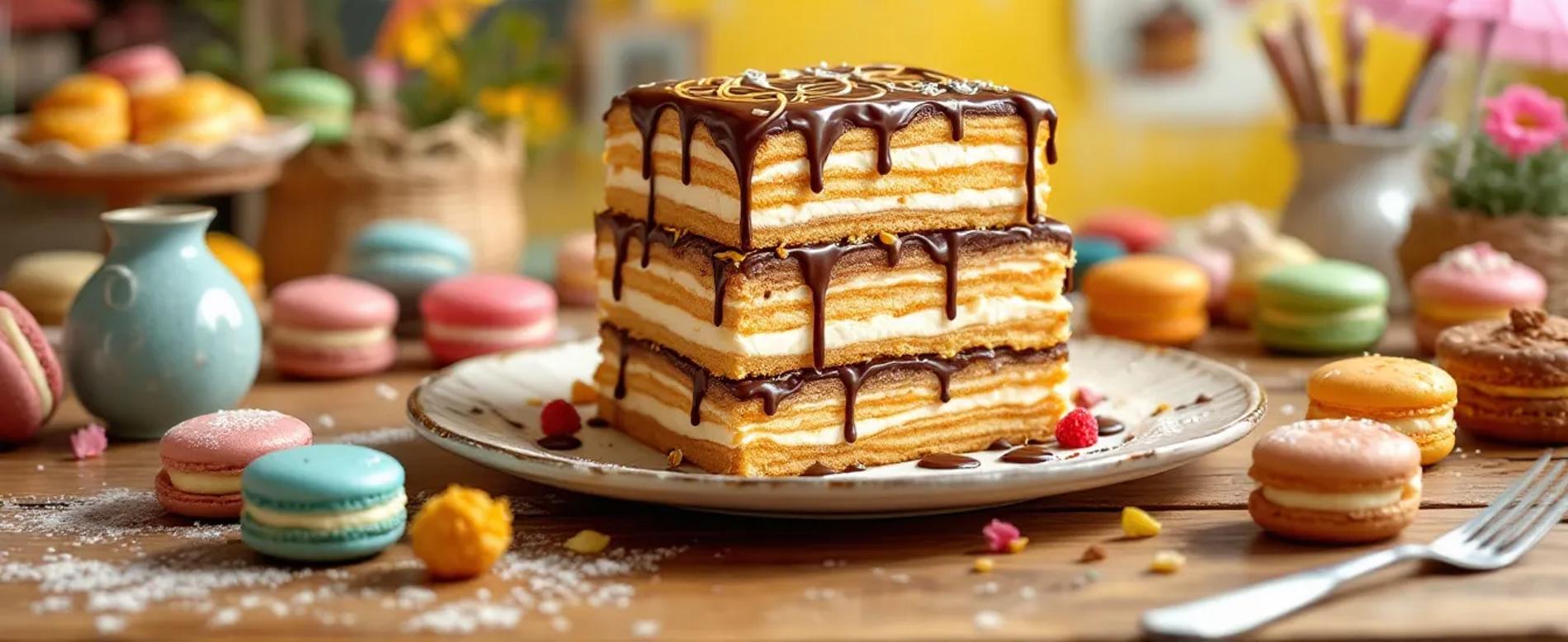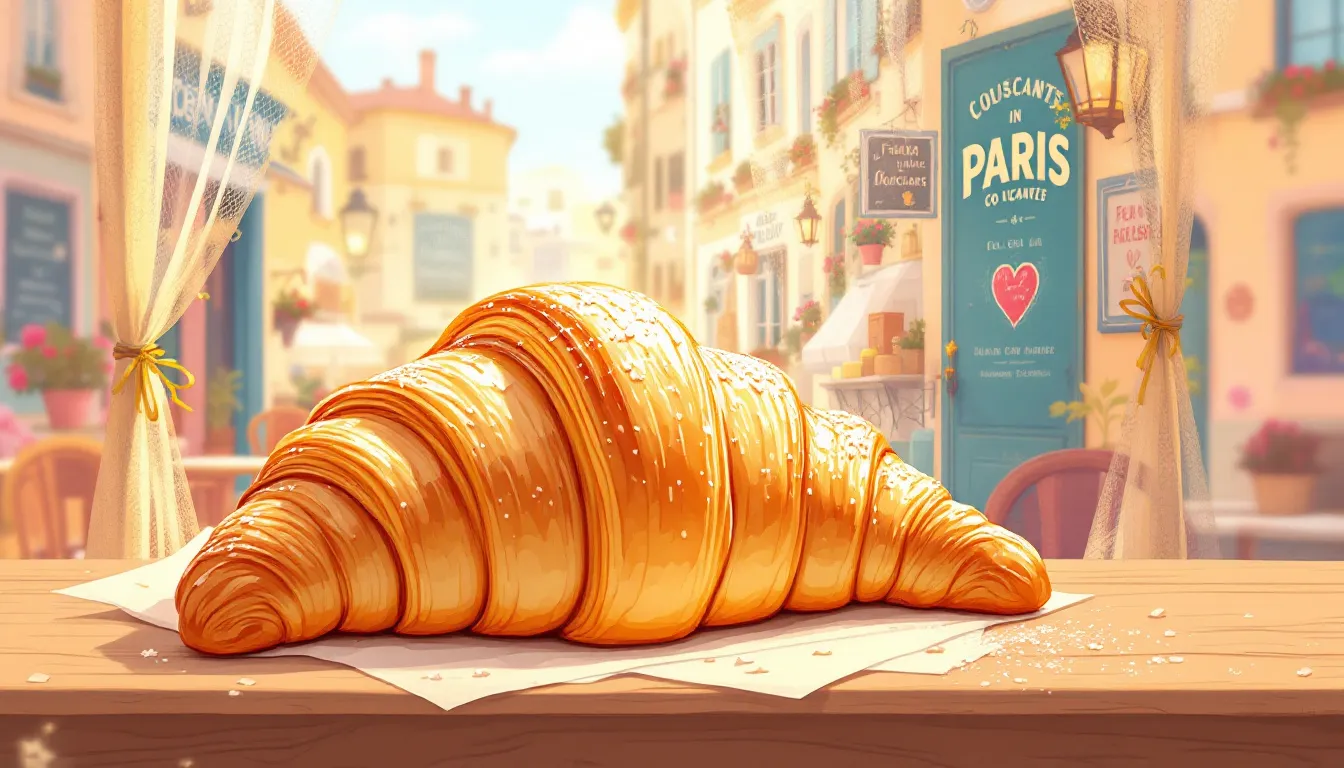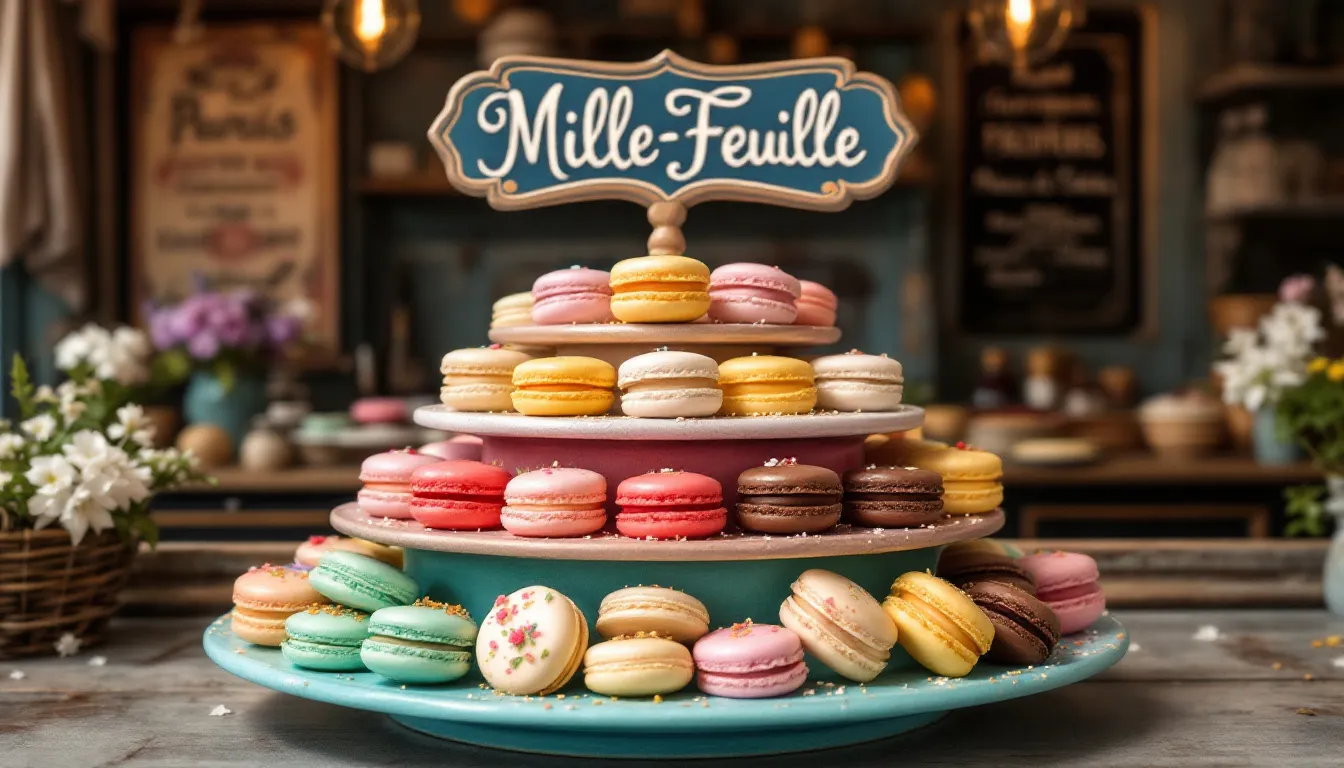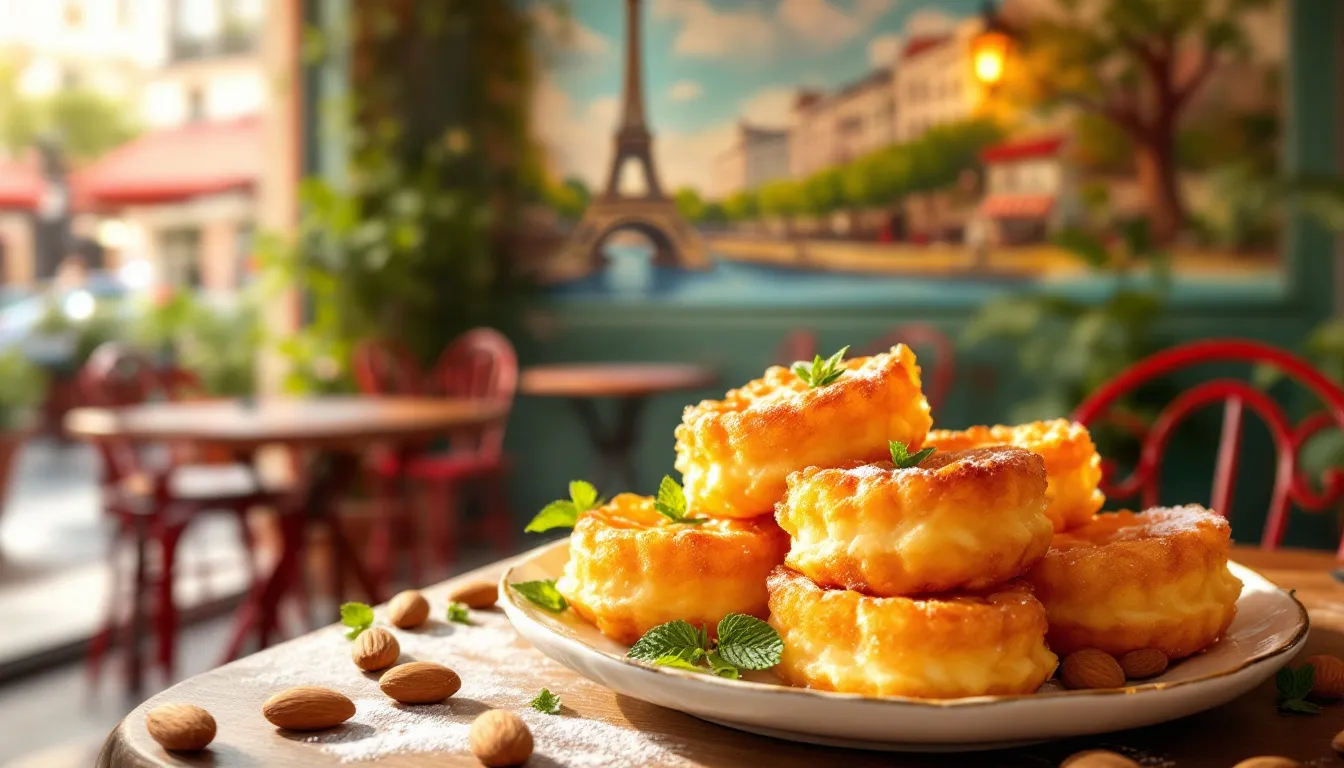

Delicious French Pastries: Top 15 You Must Try
Key Takeaways
Croissants are the ultimate French pastry, featuring a crisp outer layer and buttery interior, with global popularity resulting in a market worth around 6.66 billion USD.
Macarons, known for their vibrant colors and delicate texture, are gluten-free confections made from almond flour, with endless flavor variations offered by modern pâtissiers.
Pastries like Mille-Feuille and Éclairs highlight the artistry of French baking, showcasing layers of puff pastry or choux filled with creamy goodness and creative toppings.
Croissants: The Quintessential French Pastry

The croissant is the epitome of French pastry, a beloved classic that has become a breakfast staple around the world. This flaky pastry’s journey began with the Austrian kipferl, introduced to Paris by August Zang in 1838. The term ‘croissant,’ meaning ‘crescent’ in French, perfectly describes its distinctive shape. Its crisp outer layer and buttery interior make it an irresistible dessert for any occasion.
Croissants stand out due to their meticulous preparation, involving a laborious process of folding and rolling the dough to create delicate layers. This laminating technique, where butter is enveloped within the dough, results in a pastry that is both light and rich. Modern bakers, while respecting traditional roots, innovate with variations like almond croissants and savory versions filled with ham and cheese.
The global popularity of croissants has soared, with the market valued at approximately 6.66 billion USD and continuing to grow. Whether enjoyed plain or with a touch of jam, croissants remain a testament to the timeless appeal of French baking.
Pain au Chocolat: A Chocolate Lover's Delight

Pain au chocolat, or chocolate bread, is another beloved French dessert and a classic french pastry dessert. This delightful pastry features a rectangular piece of croissant dough filled with rich chocolate batons that melt into a gooey surprise with every bite. Achieving the perfect flaky texture requires multiple chilling and resting periods, making the dough a labor of love for any pastry chef.
A perfect pain au chocolat relies on careful preparation. The dough is shaped into rectangles to contain the chocolate filling, and an egg wash is applied before baking for a golden, glossy finish. Allowing the pastries to rise at room temperature enhances their fluffiness, resulting in an irresistible dessert that pairs beautifully with a cup of coffee or a scoop of vanilla ice cream.
Éclairs: The Elegant Choux Pastry
Éclairs epitomize elegance in the world of French pastries. Their name, translating to ‘flash of lightning,’ hints at the speed with which they are often devoured. Made from choux dough, éclairs boast a light and airy texture that is essential for their delicate form. This dough, introduced to France by Catherine de Medici, forms the basis of many classic French desserts.
The modern éclair, filled with rich pastry cream and topped with a glossy chocolate glaze, owes its popularity to Chef Antoine Carême, who first introduced the concept of filling choux pastry with cream. While chocolate custard remains a favorite, variations abound, with flavors ranging from vanilla and coffee to fruit-filled creations. The 19th-century invention of the pastry bag significantly influenced the iconic shape of the éclair.
Toppings for éclairs often include chocolate or vanilla icing, adding a sweet finish that complements the creamy interior. Whether enjoyed as a petit four or a stand-alone treat, éclairs represent the perfect marriage of simplicity and sophistication in French baking.
Mille-Feuille: The Thousand Sheets Pastry

Mille-feuille, or ‘thousand sheets’ pastry, is a French patisserie masterpiece. Originating in the 17th century, its earliest recipe appeared in a French cookbook by François Pierre de la Varenne. The recipe was later refined by the legendary chef Antonin Carême, and Adolphe Seugnot is credited with its creation in the 19th century.
A traditional mille-feuille consists of three layers of puff pastry alternating with two layers of rich pastry cream. The puff pastry sheets are meticulously baked to achieve a crisp, flaky texture that contrasts beautifully with the creamy filling. This classic French dessert is often topped with marbled fondant or a dusting of powdered sugar, adding a touch of elegance to its presentation.
Bakers frequently experiment with mille-feuille, introducing various fillings to suit different tastes. From classic vanilla cream to more adventurous fruit or chocolate fillings, the mille-feuille remains a versatile canvas for culinary creativity.
Macarons: Colorful Petit Fours

Macarons, vibrant bite-sized confections, have become synonymous with French elegance. Made primarily from almond flour, sugar, and egg whites, these gluten-free treats boast a crisp outer shell and a soft, chewy interior. Renowned bakeries like Ladurée and Saint-Emilion have elevated the macaron to an art form, selling millions annually.
Classic flavors such as pistachio, chocolate, coffee, raspberry, and vanilla remain perennial favorites, but modern pâtissiers continually push the boundaries with innovative fillings and colors. Macarons are often used as petits fours, adding a touch of color and sophistication to any dessert spread.
With their delicate balance of sweetness and texture, macarons are a must-try for anyone exploring the world of French pastries.
Tarte Tatin: The Upside-Down Apple Tart
Tarte Tatin offers a unique twist as a classic French dessert—it’s an upside-down tart. The preparation involves placing a buttery crust over caramelized fruit, typically apples, in a cast-iron skillet. This method allows the fruit to caramelize beautifully, creating a deep, rich flavor that is simply irresistible.
Flipping the tart after baking can be daunting but is necessary to prevent the caramel from hardening. Honeycrisp and Granny Smith apples are popular choices for their balance of sweetness and tartness. A sprinkle of fleur de sel enhances the caramelized apples, making this dessert a delightful blend of flavors and textures.
Brioche: Rich and Buttery Bread
Brioche, a rich and buttery bread, is classified as a Viennoiserie, a type of leavened yeast product that undergoes two proofing stages. Its high-fat content, derived from butter and eggs, gives brioche its distinctive richness and tender crumb. This versatile bread can be enjoyed plain or used to elevate dishes like French toast and sandwiches.
Refrigerating brioche dough for 24 to 48 hours after the first proofing develops its full flavor. This extended resting period allows the flavors to mature, resulting in a bread that is both delicious and indulgent.
Kouign-Amann: Brittany's Flaky Pastry
Kouign-Amann, a pastry originating from Brittany, is often hailed as the most indulgent pastry in Europe. Created around 1860 in Douarnenez, this dessert is characterized by its equal parts butter and sugar, each making up 30% of the ingredients. The name ‘Kouign Amann’ translates to ‘butter cake’ in Breton, reflecting its rich, buttery nature.
Its crisp, caramelized exterior and dense, buttery interior make Kouign-Amann a true delight. Salted butter, a staple in Brittany’s cuisine, plays a key role in Kouign-Amann’s unique flavor. With its yeasted dough and meticulous preparation, Kouign-Amann is a treat worth savoring.
Canelés: Bordeaux's Iconic Pastry

Canelés, small fluted cakes from Bordeaux, are known for their custard-like centers and hints of rum and vanilla. These pastries are traditionally baked in fluted copper molds, which efficiently conduct heat to create their signature caramelized crust. The best results are achieved by greasing the molds with a mixture of beeswax and butter, providing a glossy finish.
Allowing the batter for canelés to rest overnight develops its full flavor, and they are best enjoyed an hour after baking for optimal texture. Whether you prefer a lighter or darker bake, canelés offer a delightful taste of Bordeaux’s culinary heritage.
Paris-Brest: Celebrating a Famous Race
Created in 1910 by Louis Durand, the Paris-Brest pastry honors the Paris-Brest-Paris cycling event. Shaped like a wheel, this dessert uses choux pastry filled with crème mousseline pralinée, a rich praline cream. Topped with powdered sugar and toasted flaked almonds, the Paris-Brest is both visually appealing and delicious.
The purpose behind its creation was to commemorate the Paris-Brest bike race, and its wheel-like shape is a nod to the sport. This classic French pastry continues to be a favorite, celebrating both culinary art and athletic achievement.
Mont Blanc: Chestnut Puree Delight
Mont Blanc, named after the famous French mountain, is a delightful dessert primarily made from sweetened chestnut purée. The puree is shaped into fine strands, resembling the snow-capped peak of Mont Blanc, making it a visually stunning treat. This dessert is particularly popular in the autumn and winter seasons, often appearing in patisserie displays during early fall.
Variations of Mont Blanc have emerged over the years, incorporating flavors like chocolate and rose syrup, adding a contemporary twist to this classic dessert. Whether enjoyed in its traditional form or with a modern twist, Mont Blanc remains a favorite among chestnut lovers.
Galette des Rois: The Epiphany Cake
The Galette des Rois, or Epiphany Cake, is a flaky frangipane tart traditionally enjoyed around January 6, marking the Feast of Epiphany. Made of puff pastry filled with almond cream, this dessert features a hidden fève or lucky charm inside. The person who finds the fève is crowned king or queen for the day, adding a fun and festive element to this classic French dessert.
Often topped with intricate designs and a dusting of powdered sugar, the Galette des Rois is both beautiful and delicious. Its rich almond filling and buttery pastry make it a must-try for any pastry enthusiast.
Chausson aux Pommes: Classic Apple Turnover
Chausson aux pommes, a classic French apple turnover, is shaped like a semi-circle or ‘slipper.’ Typically, the apples are stewed with a hint of cinnamon, creating a warm and comforting filling. A leaf design is often cut into the pastry before baking, enhancing its presentation, and a sugar syrup is brushed on top for a sweet glaze and shine.
This delightful pastry is celebrated during the Fête du Chaussons aux Pommes, a festival that honors its deliciousness. Whether enjoyed warm or at room temperature, chausson aux pommes is a perfect blend of flaky pastry and sweet apple filling.
Financiers: Almond-Flavored Tea Cakes
Financiers, almond-flavored tea cakes invented in the 17th century, are named for their mold resembling a gold bar. Made from almond flour, egg whites, and beurre noisette, these cakes have a crisp exterior and a soft, moist interior. The almond flour gives financiers their distinct flavor and texture, making them a popular choice for tea time.
These petite cakes are perfect for a mid-afternoon snack or as a sophisticated addition to any dessert spread. Their rich, nutty flavor and delicate texture make them an irresistible dessert.
Madeleines: Shell-Shaped Tea Cakes
Madeleines, shell-shaped tea cakes made from eggs, flour, sugar, and butter, offer a rich flavor without being greasy. Their distinctive shape, achieved using special molds during baking, makes them instantly recognizable. Traditionally enjoyed during the late afternoon meal known as ‘goûter,’ madeleines are classified as ‘gâteaux de voyage,’ meaning they are easy to carry and perfect for travel.
A typical madeleine recipe yields around 12 to 18 cakes, depending on the mold size. Whether plain or dipped in chocolate, madeleines are a delightful treat that adds a touch of French elegance to any tea time.
Summary
Exploring the world of French pastries is like taking a delicious journey through France’s culinary history and creativity. From the quintessential croissant with its buttery, flaky layers to the delicate and colorful macarons that melt in your mouth, each pastry tells a story of tradition, innovation, and sheer indulgence. We’ve covered a wide range of pastries, each with its unique characteristics and preparation methods, showcasing the diversity and richness of French dessert culture.
Whether it’s the crisp and caramelized Kouign-Amann, the custard-filled éclairs, or the festive Galette des Rois, French pastries offer something for every palate. These delightful treats not only satisfy your sweet tooth but also offer a glimpse into the artistry and passion of French baking. So, next time you crave something sweet, why not try making one of these irresistible desserts at home? Bon appétit!
Frequently Asked Questions
What are popular pastries in France?
If you're diving into French pastries, definitely try macarons, éclairs, and pain au chocolat; they’re super popular and oh-so-delicious! You won't regret indulging in a mille-feuille or a profiterole either!
What is the hardest French dessert?
Canelé is widely regarded as one of the hardest French desserts to master, thanks to its tricky texture and perfect caramelized crust. So, if you're up for a challenge, give it a shot!
What is France's most famous dessert?
Crème brûlée is definitely France's most famous dessert, loved for its creamy custard and crunchy caramelized top. You can't go wrong with this classic!
What makes French pastries unique?
French pastries stand out for their perfect blend of flavors and the skilled techniques used in making them, like dough laminating and using top-notch ingredients. These elements come together to create treats that are both rich in taste and tradition.
How is a croissant different from a pain au chocolat?
A croissant is crescent-shaped and plain, while a pain au chocolat is rectangular and has chocolate filling. So, if you're in the mood for chocolate, definitely go for the pain au chocolat!

